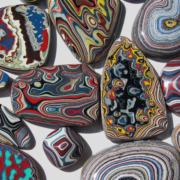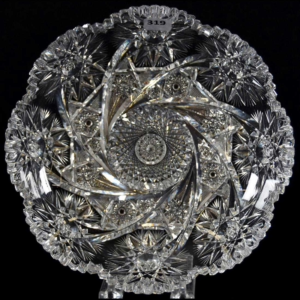Fordite – properties, virtues & benefits
Fordite didn’t get its name by accident, coming to us directly from the Detroit-based factories of one of the first automotive giants: Ford. As you’re about to discover, the conditions of its emergence on the market are, to say the least, unprecedented.
FORDITE FEATURES
- Chakra: /
- Properties: Aesthetics, industrial history.
- Astrology: /
- Zodiac: /
- Elements: Hardened automotive paint.
- Colors: Multicolor.
- Hardness: 4-5 (Mohs scale).
- Chemical Formula: /
- Associated God: /
FORDITE – HIS HISTORY
At the beginning of the last century, the paints used for bodywork and the way they were applied were different from those we know today. Back then, paint was either applied by hand or sprayed on directly. This inefficient process left drips that built up over the years, becoming cumbersome and problematic once the paint had been polished and dried. The first harvests of Fordite were the result of workers cleaning up years of accumulated paint on the very first modern production line.
Some employees began to notice the brilliance and particular beauty of these dripPings and began to collect them, even turning them into jewelry. Mineralogists took over, harvesting Fordite for the workers and introducing it to the world. Today, as automobile production lines have modernized, Fordite has become rare and precious, as it is hardly ever harvested. Ford has been able to make a better return on its paints desPite the happy aftermath.
FORDITE STONE – ITS ORIGIN AND COMPOSITION
Although fordite can easily be mistaken for an agate, it cannot be classified as a gemstone per se. Indeed, fordite is neither a rock nor a mineral, but rather a mass of synthetic paint debris. This paint is mainly composed of nitrocellulose (or cellulose nitrate) and chemical colorants, and its hardness and beauty are only due to repeated passes through the gears of the booming automobile production of the time.
.
Due to these random characteristics of Fordist production at the time, fordite is available in a wide variety of sizes and weights, but can be uniquely polished to produce vibrant colors. This variety has excited collectors around the world, who have adopted Detroit Agate with a passion.

FORDITE STONE – VERTIES AND PROPERTIES
As you’ve gathered, the interest of stones in the fordite category lies mainly in their great beauty and their connection with the history of man and his industry. Unlike traditional gemstones, they have no recognized effect in lithotherapy. However, they are much appreciated by collectors, nostalgic car enthusiasts and lovers of aesthetic art.
In short, the value of fordite lies not in its lithotherapeutic properties, but rather in the emotion it arouses in those who possess and contemplate it.
FORDITE ON THE PSYCHOLOGICAL LEVEL
There are no particular psychological virtues associated with fordite stone, apart from the simple pleasure of owning an original Piece steeped in history. In other words, fordite provides no specific psychological benefits, but it can be a source of personal satisfaction for those who appreciate its uniqueness and its link with the history of the automotive industry.
PHYSICAL FORDITE
Fordite stone, also known as Detroit agate, has no particular virtues on the physical level. In other words, it provides no health benefits. Rather, its interest lies in its charm and aesthetic appeal.

FORDITE STONE – CLEAN AND RECHARGE
Fordite stone, although an industrial product and not a natural crystal or mineral, may require cleaning and recharging to preserve its appearance. Here are a few steps to maintain your fordite:
Cleaning:
- Use a soft, dry cloth to remove dust and dirt from the fordite’s surface.
- If more thorough cleaning is required, lightly dampen a soft cloth with lukewarm water and gently wipe the stone. Avoid using detergents or harsh chemicals that could damage the fordite.
Recharging: Since fordite is not a crystal or mineral with energetic properties, the concept of recharging does not apply in the same way. However, to preserve and revive fordite’s colors, you can place it in indirect sunlight for a few hours. Avoid prolonged direct exposure to the sun, as this may discolor or damage the stone.
It’s important to note that fordite has no recognized metaphysical or energetic properties. Its appeal lies in its aesthetic appearance and industrial history.
WHERE DOES THE NAME FORDITE COME FROM?
The name “fordite” comes from the American car brand Ford. Fordite stone was created accidentally in automotive paint plants, notably those of the Ford company, during the vehicle painting process. Successive layers of paint accumulated and hardened in the paint booths, forming colored agglomerates.
Although fordite can be found in various automotive plants, the name “fordite” has become the generic term to describe these accumulations of hardened paint, due to the historical association with the Ford plant and the brand’s popularity.
WHICH CHAKRA DOES FORDITE ACT ON?
Fordite is not a crystal or natural stone with recognized energetic or metaphysical properties. Its appeal lies mainly in its aesthetic appearance and industrial history. Consequently, fordite is not generally associated with a specific chakra or healing properties. Rather, it is appreciated for its beauty and uniqueness as a material derived from the automotive industry.
WHICH ASTROLOGICAL SIGN IS ASSOCIATED WITH FORDITE?
Fordite is not a natural stone with recognized energetic or metaphysical properties, so it’s not usually associated with a particular astrological sign. Its appeal lies mainly in its aesthetic appearance and industrial history. Fordite is appreciated for its beauty and uniqueness as a material derived from the automotive industry, rather than for any esoteric or astrological attributes.
FORDITE STONE SUMMARY
Fordite stone, also known as “strait agate” or “detroite”, is an unusual and fascinating material. Although it resembles a brightly colored gemstone, fordite is not a natural stone, but rather an industrial by-product.
Origin and formation: fordite originated in former automobile paint factories, mainly in the USA, where vehicles were painted by hand. Excess paint built up layer after layer, forming solid, colored deposits that hardened over time. These deposits were discovered by workers who recovered and shaped them to create art objects and jewelry.
Features: fordite features unique patterns and vivid colors, with interwoven layers of paint that give the illusion of gemstone strata. Each Piece of fordite is unique due to the variety of paint colors used and the way they have accumulated.
Uses: Fordite is used primarily to create objets d’art and jewelry, such as pendants, rings, earrings and cufflinks. Artisans appreciate its rarity and distinct patterns to design unique and attractive Pieces.
Value and availability: fordite has become increasingly rare due to the evolution of automotive painting methods and the reduction in production of this material. This scarcity has led to an increase in the value of fordite, which is now considered a collector’s item and a curiosity among stone enthusiasts and automotive history buffs.
In summary, fordite stone is a unique and fascinating material that reflects the history of the automotive industry and offers captivating patterns and colors for objets d’art and jewelry. Although its availability is limited, it remains a sought-after curiosity for collectors and craftsmen.


